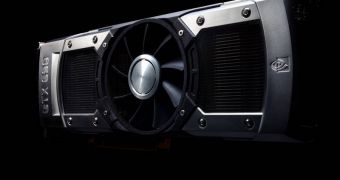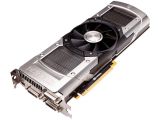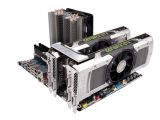Nvidia has just announced the GeForce GTX 690 dual GPU video card on its official website. This is a design that’s surprisingly close to the GTX 680 SLI specifications and, just as we said, it launches just a month after the GTX 680.
The new GTX 690 is powered by two fully fledged GK104 very efficient GPUs. As we already suspected here, the GTX 690 design will not handicap the GK104 GPU like the GTX 590 did.
GTX 590 has significantly lower GPU and memory frequencies, but that was expected at the time, as the regular GTX 580 card has a TDP of almost 250 watts. Doubling that would have meant that the dual GPU GTX 590 was supposed to handle and be able to cool a huge 500 watts worth of heat.
So, instead, Nvidia went for a more modest clocking of the GPUs mounted in the GTX 590 card.
The situation is different with the GK104. The efficient design of the architecture and the close collaboration with the GPU’s manufacturer, TSMC, yielded a generation of GPUs with much lower heat dissipation than the older 40 nm GeForce 580.
Therefore, the GTX 690 card will sport the same 6008 MHz GDDR5 memory frequency, despite the fact that it comes with a 2 x 2 GB memory configuration. The memory BUS width will be the same 256 Bit in a 2 x 256 Bit configuration.
As each GK104 GPU is comprised of 3.5 billion transistors, the GTX 690 video card will come with a total of 7 billion transistors built on TSMC’s 28 nm process, offering an architecture that’s capable of 1/24 FP32 double precision floating point.
Consequently, we have 2 x 1536 CUDA cores clocked at a decent 915 MHz base clock with the possibility of a boost clock of 1019 MHz.
Thus, Nvidia’s dual GPU combination of the GK104 GPUs will come with a 9% lower core clock and just a 3.5% lower boost clock. Basically, we have double GeForce GTX 680 performance in a single card.
As we’ve said before, the GK104 design on the 28 nm process is so efficient that it’s expected that Nvidia won’t have to do too much binning to find GPUs with higher than average power qualities. The GTX 580 GPUs that were suitable for the GTX 590 dual GPU configuration were much more rare and harder to find than the GK104 GPUs.
The default power target for the GTX 690 board is 263 watts. That’s the full load power of the card without benefiting from any boost in GPU clocks. The total TDP is 300 watts.
Power will be administrated through two 8-pin power connectors that allow the card to draw up to a high 375 watts. So overclockers should be quite safe and achieve good results, even with the standard design.
The card’s 10 power phases, 5 phases for each GPU, will take care of cleaning and leveling the current .
Software-wise, the GTX 690 will have an adjustable power target and clock frequency just like the GTX 680 has. NVIDIA’s GTX 690 has a max power target of plus 35%, which, given the card’s default power target of 263 watts, means you can set it up in the software and allow it to draw up to 355 watts of power.
New to the dual GPU GTX 690 is the use of the PLX PCIe 3.0 bridge chip. Nvidia’s previous dual GPU card, the GTX 590 was still using the NF200 PCIe bridge chip designed by Nvidia’s own chipset division. Since Nvidia’s chipset division has been restructured and the NF200 chip was a PCIe 2.0 bridge, the company went to a 3rd party for a new PCIe 3.0 certified bridge.
While Nvidia has not yet released the full specifications of the card, we can easily see inthe official pictures that the cooling system has one big fan in the middle of the card, that’s pushing the hot air out in the front and back of the card. This means that the hot air coming from cooling the GPU situated first on the left will go out of the system case and in the back of the computer. The hot air coming from the right GPU will be unfortunately blown inside the case.
This design has its advantages. As the GTX 690 is not such a hot card as the GTX 590 was, the amount of heat dissipated inside the case will be practically less than what a normal single GPU GTX 680 would dissipate in all those custom designs that aren’t pushing the heat out.
Therefore, the rotation speed of this central fan will be much lower than a turbine-like back blowing fan. Those turbine-like fans usually have to rotate faster than this design, as they’re pushing the air through a much longer tunnel and the friction of the air with the fins is slowing the air speed down. Thus a back, turbine-like fan needs to spin at a higher speed to compensate.
The cooling is using two separate vapor chamber radiators located on the two GPUs.
This is the first time we’ve seen a vapor chamber used with a 600 series card.
On the connectivity side, Nvidia is using the same 3x DL-DVI and 1x miniDP port configuration that we saw on the GTX 590.
Pricing is quite an unfortunate surprise.
It seems that Nvidia wants to ride the wave of Kepler’s popularity and, at least until AMD launches its own dual GPU card, the official price will be a record 999 USD. That’s around 750 EUR for the European gamers, but we expect that Nvidia won’t miss the chance to overcharge them and we expect prices closer to the 900 EUR mark.
This makes the GTX 690 the most expensive GeForce card in the history of the company. Even the 2007 launched GeForce 8800 Ultra seems cheap at its official launch price of 830 USD.
Since TSMC is so capacity-constrained and the demand for regular GTX 680 is so high, the initial availability of the GTX 690 card will appear similar to a paper launch, but that’s not the case. Nvidia has everything it needs to make as many GTX 690 card as the customers want, but right now, since there are so many GTX 680 customers, the GTX 690 will be quite rare, as most of the GPU’s will go the GTX 680 way.
Wider availability is expected starting May 7th, while the initial reviews should be popping up in the next two days.

 14 DAY TRIAL //
14 DAY TRIAL // 


